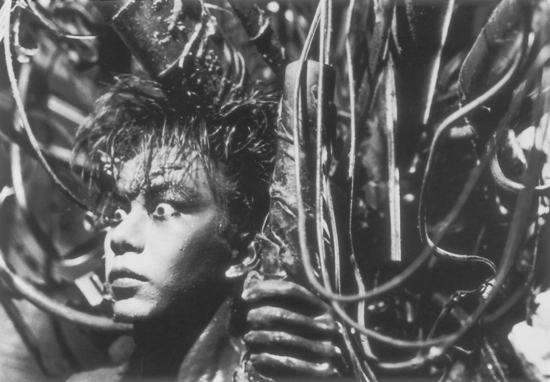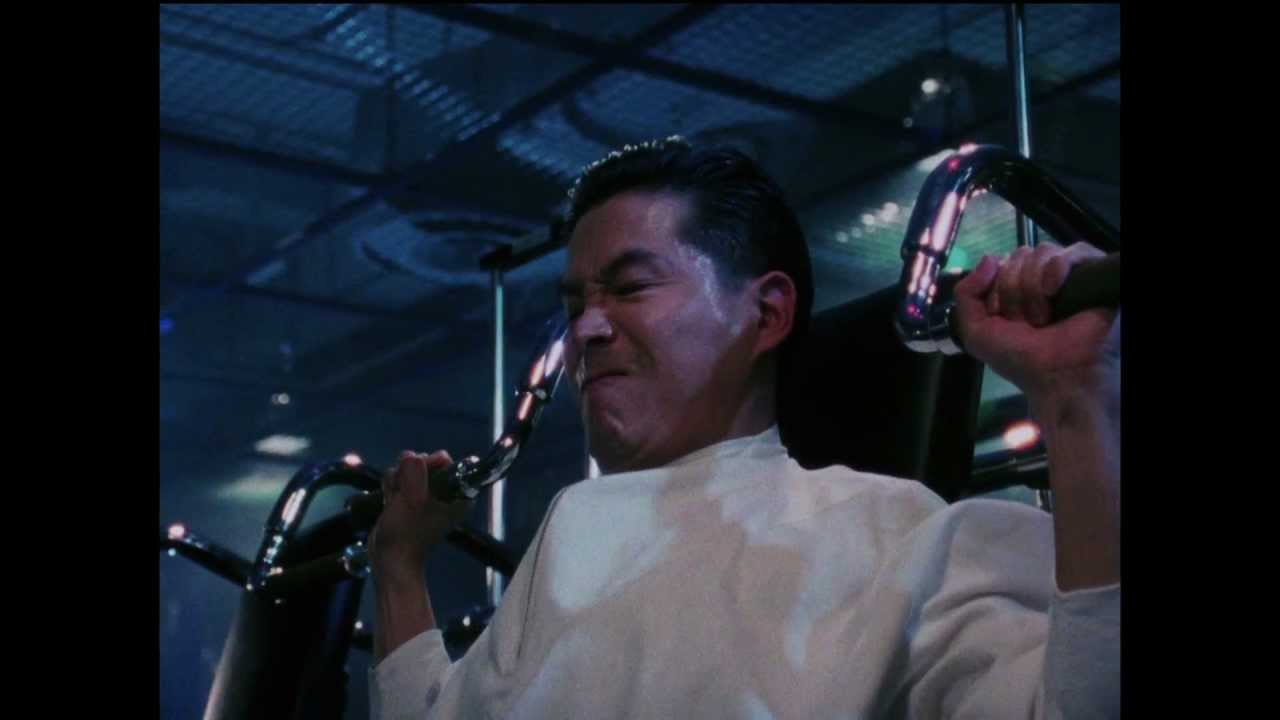It was surely inevitable that Shinya Tsukamoto’s feature debut and London’s premier venue for all things cult and leftfield would cross paths. 1989’s Tetsuo: The Iron Man and the Scala Cinema were made for each other. Here this odd little film, about an everyday salaryman who slowly mutates into a machine, could rub shoulders with its kin. Like David Lynch’s Eraserhead it was shot in black and white and boasted a stunning industrial soundscape. Like David Cronenberg’s early features it had an ethos best summed up, to borrow Videodrome‘s phrase, as "Long Live the New Flesh". And like any number of Scala selections its subversion was immediate from the off. Hardly surprising, then, that fans of Pink Flamingos, Thundercrack! and Salò eagerly lapped it up.
Watching Tetsuo back then (or, in my case, late one Friday night on Channel 4 in the mid-’90s) the overwhelming sensation was one of awe. Debut features were rarely so confident, so fully formed, so perfectly governed by their own logic. Everything had fallen into place, from Chu Ishikawa’s abrasive score to the distinctive visual techniques that switched incessantly between live action and animation. More importantly, it felt like nothing else. While we can point towards Lynch and Cronenberg or even ponder the influence of Sogo Ishii’s Halber Mensch (an Einstürzende Neubauten concert film from 1986 shot partially in a Japanese industrial wasteland), this was clearly the product of a highly distinctive new talent.
And yet Tsukamoto had been honing his cyberpunk tale for some years. Amazingly, he’d even mounted a stage version prior to rolling the cameras. Key to Tetsuo‘s development was a pair of short films made during the 1980s, The Phantom Of Regular Size and The Adventures Of Electric Rod Boy. Here the auteur toyed with some ideas that would make the upgrade to feature length, including the whole man-machine angle and crude renditions of the stop-motion animation techniques. He hadn’t quite settled on a tone, however, which meant that …Electric Rod Boy also found room for a cute comedy romance, vampires, samurai swords and time travel. If you had to pick an influence, you’d likely opt for Nobuhiko Ôbayashi’s demented haunted house movie Hausu rather than Eraserhead.
Ultimately the industrial nightmares won out; any humour in Tetsuo was of the blackest variety (the drill-piece penis, especially). And whenever Tsukamoto has returned directly to its subject – for Tetsuo II: Body Hammer in 1992 and Tetsuo: The Bullet Man in 2009 – that situation has never really changed. His approach has become increasingly mainstream up to a point, with the first sequel adding colour photography to the mix and the third instalment being filmed in English, but they never stray too far. The style and the atmosphere have simply grown more refined (for better or worse) and Tsukamoto’s fingerprint has become immediately recognisable.
Of course, there’s been much more besides the Tetsuo saga these past 23 years, with Tsukamoto lending his name to ten further features and one anthology. Some play out like variations on the common theme (1995’s Tokyo Fist, for example, shares the hyperkinetic feel and sees another salaryman undergo a transformation, this time as he takes up boxing in a game of one-upmanship with a love rival), though it isn’t quite that simple. Tsukamoto’s filmography can be split into two sections: the mutations and the diversions. The former continue where Tetsuo left off, offering up what feel like deeply personal works. The latter see the filmmaker head off into more commercial territory, almost as though he were a director-for-hire.
Among the diversions we find Hiruko The Goblin, released in 1991 between the first two Tetsuo flicks, which really brought out the Hausu influence hinted at in …Electric Rod Boy. Massively entertaining, but far removed from the usual nightmares. Gemini from 1999, on the other hand, offered up period horror thrills in a tale of a vengeful twin brother, while 2004’s Vital opted for a classier brand of psychodrama. Here the camera no longer fidgeted and an orchestral soundtrack replaced the usual white noise. Most mainstream of all was Nightmare Detective 2 (2008), which saw Tsukamoto get in on the schoolgirl horror angle and make use of the familiar lank-haired ghost. Interestingly, the director didn’t appear in any of these films, further suggesting a lack of immediate connection.
Indeed, if you want a proper Tsukamoto movie then look for his name in the cast list. In Tetsuo he was the ‘metal fetishist’, in its sequels he was simply ‘the guy’, and in all of his personal works he takes on a significant role, oftentimes the lead. The salaryman who takes up boxing in Tokyo Fist? The widower who becomes obsessed with weaponry following his wife’s suicide in 1998’s Bullet Ballet? The controlling figure who manipulates an unloving couple’s sexless marriage in A Snake Of June (2002)? All Tsukamoto. Note, too, the progression from Tetsuo‘s uncomprehending mutant to willingly embroiled participants to the man fully in charge. As the director becomes more aware of this landscape of his own creating (and it’s tempting to see the personal works as individual stories within a wider canvas) so too has his presence become more assured.
Other filmmakers have since picked up on this developing persona and been keen to make use of it. Takashi Miike has cast Tsukamoto a couple of times, most tellingly as a steroid-ridden psychopath in Ichi The Killer (bodybuilding merely being mainstream mutilation). Another key role came in Marebito, a 2004 horror from Takashi Shimizu, the man behind The Grudge. Here Tsukamoto played an obsessive cameraman who discovers a netherworld below the Tokyo subway system and, more importantly, a young female vampire whom he takes back to his apartment. Around the same time the director was subject to an hour-long documentary for Japanese TV, but I like to imagine that Marebito is much nearer the truth.
Most recently his cinema has undergone a fresh mutation. Last year’s Kotoko wasn’t his brainchild, but that of the popular Japanese folk rock singer Cocco. Though Tsukamoto wrote the screenplay, she came up with the tale: that of a young mother suffering from a particularly violent mental illness. Unable to distinguish between fantasy and reality (in Kotoko’s eyes the two literally coexist within the same moment), only bouts of self-harm appear to present concrete facts. Her grip loosening, she gives up her child to her sister and descends into an ever-decreasing world. Just the four walls of her apartment and unceasingly nasty fantasies keep her company, or at least until Tsukamoto’s latest onscreen incarnation puts in an appearance.
The role is an interesting one, that of a self-confessed stalker who willingly puts up with Kotoko’s violent attacks whenever the mood swings take over. Cocco pummels Tsukamoto to a bloody and an almost comical degree, memory traces of Tokyo Fist and Tetsuo‘s confrontations lingering despite the vérité filming style suggesting ultra-realism. In fact, there’s a temptation to view these scenes as indicative of Kotoko as a whole, wherein the director submits to the will of his lead actress as she attempts to take control of his movies. This is recognisably a Tsukamoto picture, but it is Cocco who really owns it. She appears in every scene and absolutely dominates the frame (despite having never acted before), plus she picks up an additional credit as art director. It’s almost as though she has attacked the film from within.
The question now is where does Tsukamoto go from here? Does he relinquish control of the next picture or snatch the reins back and firmly enforce himself on the material once more? Certainly, Kotoko comes with a thrill and an intensity that arguably hasn’t been quite replicated since Tetsuo. As such, a whole series of joint ventures with Cocco are an enticing prospect. With Kotoko as the fresh starting point who knows where the next mutation could lead. Either way, Tsukamoto remains a filmmaker worth keeping an eye on.
Tetsuo: The Iron Man / Tetsuo II: Body Hammer and Kotoko are out now on Blu-ray and DVD through Third Window Films.





